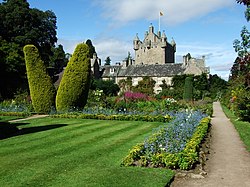Cawdor
| Cawdor Gaelic: Caladar | |
| Nairnshire | |
|---|---|
 Cawdor Castle | |
| Location | |
| Grid reference: | NH846486 |
| Location: | 57°30’49"N, 3°55’37"W |
| Data | |
| Post town: | Nairn |
| Postcode: | IV12 |
| Local Government | |
| Council: | Highland |
| Parliamentary constituency: |
Inverness, Nairn, Badenoch and Strathspey |
Cawdor is a village and parish in Nairnshire. The village lies 5 miles south south west of Nairn, and 12 miles from Inverness. The village is the location of Cawdor Castle, the seat of the Earl Cawdor.
Contents
Macbeth
William Shakespeare made this wee village world-famous, through brief mentions in Macbeth.
| “ | All hail, Macbeth! hail to thee, thane of Glamis! |
” |
In the beginning of the play, Macbeth is Thane of Glamis. Unbeknownst to him the Thane of Cawdor has been condemned as traitor and executed and King Duncan has bestowed the title on Macbeth. Thus he sees the witches' hail as a prophecy he is determined to fulfil.
The oldest part of Cawdor Castle dates from the 14th century, and it has no predecessor.[2] Therefore, in Macbeth's time there was no castle from which a Thane of Cawdor might haeve held court, notwithstanding the long tradition from which Shakespeare wove his play. That is not to say that there was no Thane governing hereabouts, but no trace of the doubly-treacherous title is found in the soil.
The Campbells of Cawdor and the name of the village
An earlier name for the village appears to have been Caddell locally, but known also as Calder, as may be seen an Act of Parliament passed in 1641 under King James VI, entitled "Act in favoures of the lairde off Caddell" but who is named in the text as "Schir Johnne Campbell of Calder, knycht".
The Campbells came from Argyll, but in 1510 a younger son of the Earl of Argyll, Sir John Campbell, married Muriel, heiress of the Thane of Caddell. From 1524 to his death in 1546, Sir John Campbell of Caddell lived at Caddell Castle and after Muriel's death in 1573, the Thanedom was resigned in favour of her grandson, John Campbell, from whom a line of Thanes descended until one, also John, was made Lord Caddell of Castlemartin in 1797, and his son and heir, John Fredrick Campbell, became Earl of Cawdor, from whom the Earls of Cawdor are descended.
The name "Cawdor" appears in Holinshed's Chronicles, which include the tale of the three witches recounted exactly if more by Shakespeare ("Hayle Makbeth Thane of Cawder"). In the early 19th century, the Laird (who did not reside in the Castle at that time) changed the name of the castle, town and his clan overnight so that it would match the Shakespearian designation.[3]
History
Roman Fort
In 1984, a strong candidate for a Roman fort was identified at Easter Galcantray, south west of Cawdor, by aerial photography.
The site was excavated between 1984 and 1987 and several features were identified which are of this classification.
A single fragment of Roman coarse ware was found in the bottom of the ditch outside the south-west gateway along with burnt material; this pottery has very similar fabric to that found at Inchtuthill. In addition to this sparse pottery evidence, the demolition deposits in the western ditch yielded a piece of charcoal which has been radiocarbon dated to A.D. 80-130 (Calibrated).[4]
The radiocarbon test gave a possible date of construction during Agricola campaign.[5]
Cawdor Roman fort is probably the most northerly known Roman fort in the British Isles.[6]
Local community
The area has recently received a new school building as the old school was over one hundred years old and could not fit all of the pupils and had been using huts (pre-fabricated caravan-like structures) to make room. The area also has a village shop which recently has been struggling financially for the past few years, but still is useful for the community.
Outside links
- Cawdor Castle website
- Sunday Times article, "The Curse of the Cawdors", detailing recent family history
References
- ↑ Macbeth, Act 1, Scene 3, line 6
- ↑ [1]
- ↑ According to the Cawdor Historical Society
- ↑ Roman Britain Organisation
- ↑ Excavations at Cawdor 1986
- ↑ Roman fort near Inverness